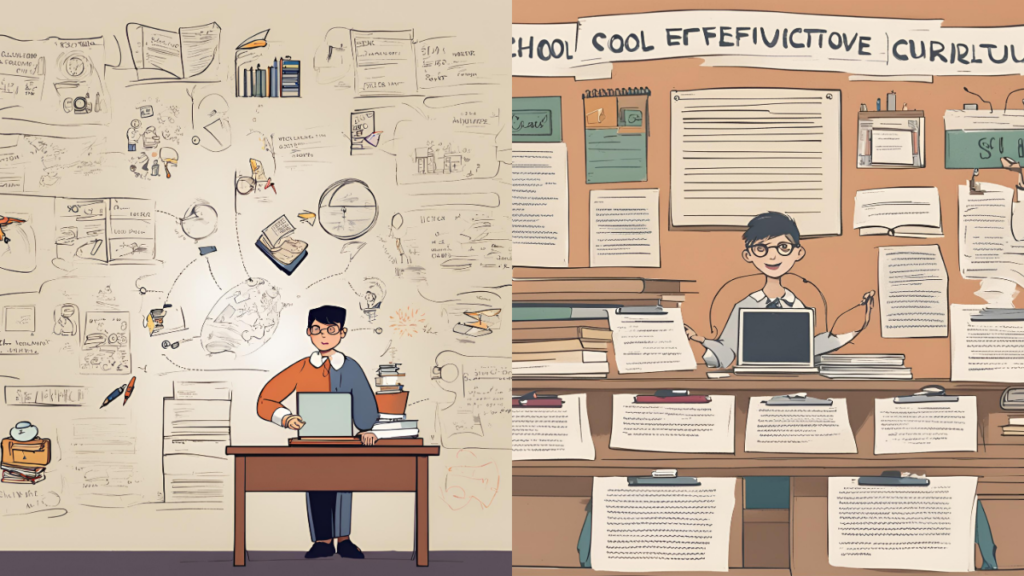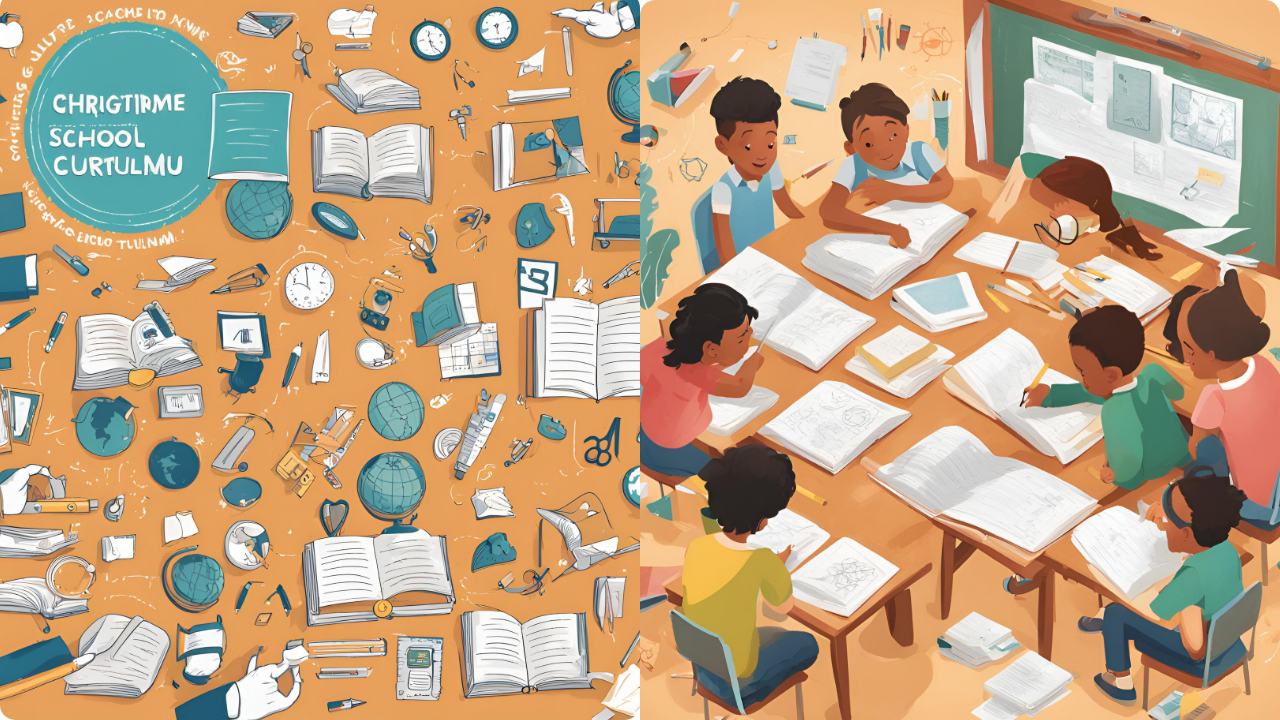Table of Contents
1. Introduction
1.1 Definition of a School Curriculum
1.2 Importance of a Well-Designed Curriculum
1.3 Goals of an Effective Curriculum
1.4 Overview of the Process
2. Foundations of Curriculum Development
2.1 Historical Context
2.2 Educational Theories
2.3 Key Influencers in Curriculum Design
3. Curriculum Design Principles
3.1 Student-Centered Learning
3.2 Inclusivity and Diversity
3.3 Alignment with Educational Standards
3.4 Flexibility and Adaptability
4. Curriculum Components
4.1 Objectives and Learning Outcomes
4.2 Content and Subject Matter
4.3 Teaching Methods and Strategies
4.4 Assessment and Evaluation
4.5 Resources and Materials

5. Steps in Developing a School Curriculum
5.1 Needs Analysis
5.2 Defining Goals and Objectives
5.3 Designing the Curriculum Framework
5.4 Developing Content
5.5 Implementation Planning
5.6 Evaluation and Feedback
6. Curriculum Implementation
6.1 Teacher Training and Professional Development
6.2 Classroom Management
6.3 Student Engagement Strategies
6.4 Use of Technology in the Classroom
6.5 Continuous Improvement
7. Assessing and Evaluating the Curriculum
7.1 Formative and Summative Assessments
7.2 Feedback Mechanisms
7.3 Curriculum Review and Revision Process
7.4 Case Studies of Effective Curricula
8. Challenges in Curriculum Development
8.1 Balancing Standardization and Customization
8.2 Addressing Diverse Student Needs
8.3 Keeping Up with Technological Changes
8.4 Funding and Resource Allocation
9. Future Trends in Curriculum Development
9.1 Integration of STEM and STEAM
9.2 Emphasis on Soft Skills and Emotional Intelligence
9.3 Global Perspectives and Multicultural Education
9.4 Personalized Learning Pathways
10. Conclusion
10.1 Summary of Key Points
10.2 The Impact of an Effective Curriculum
10.3 Call to Action for Educators and Administrators
Content Writing
1. Introduction
1.1 Definition of a School Curriculum
A school curriculum is a comprehensive framework that outlines the educational content and learning experiences provided to students throughout their schooling. It encompasses the subjects taught, the skills developed, the values instilled, and the methodologies employed to facilitate learning.
1.2 Importance of a Well-Designed Curriculum
A well-designed curriculum is crucial for ensuring that students receive a balanced and comprehensive education. It helps in developing critical thinking, problem-solving skills, and prepares students for future academic and professional endeavors. Additionally, it promotes equity by providing all students with access to the same quality of education.

1.3 Goals of an Effective Curriculum
The primary goals of an effective curriculum include fostering a love for learning, developing essential academic skills, nurturing creativity and critical thinking, promoting social and emotional development, and preparing students for higher education and career challenges.
1.4 Overview of the Process
Creating an effective school curriculum involves several stages, including needs analysis, goal setting, designing the curriculum framework, developing content, planning for implementation, and continuous evaluation and improvement.
2. Foundations of Curriculum Development
2.1 Historical Context
The development of school curricula has evolved significantly over the years, influenced by various educational reforms and societal changes. Understanding the historical context helps in appreciating the current practices and anticipating future trends.
2.2 Educational Theories
Educational theories play a pivotal role in curriculum development. Theories such as constructivism, behaviorism, and cognitivism offer insights into how students learn, which informs the design of teaching methods and content.
2.3 Key Influencers in Curriculum Design
Prominent educators and philosophers, such as John Dewey, Maria Montessori, and Benjamin Bloom, have significantly influenced curriculum design. Their contributions emphasize experiential learning, developmental appropriateness, and the importance of measurable learning outcomes.
3. Curriculum Design Principles
3.1 Student-Centered Learning
An effective curriculum prioritizes student-centered learning, where the needs, interests, and abilities of students are the focus. This approach encourages active participation and engagement in the learning process.
3.2 Inclusivity and Diversity
Incorporating inclusivity and diversity in the curriculum ensures that all students, regardless of their background, have equal opportunities to succeed. This involves integrating multicultural education and differentiated instruction.

3.3 Alignment with Educational Standards
Curriculum design must align with local, national, and international educational standards to ensure consistency and quality in education. Standards provide benchmarks for academic achievement and skill development.
3.4 Flexibility and Adaptability
A flexible and adaptable curriculum can respond to changes in educational research, technology, and societal needs. This allows for continuous improvement and relevance in the curriculum content and delivery.
4. Curriculum Components
4.1 Objectives and Learning Outcomes
Clearly defined objectives and learning outcomes provide direction and purpose for the curriculum. They outline what students should know and be able to do by the end of a course or grade level.
4.2 Content and Subject Matter
The content and subject matter form the core of the curriculum. This includes the knowledge, concepts, and skills that students are expected to learn in each subject area.
4.3 Teaching Methods and Strategies
Effective teaching methods and strategies are essential for delivering the curriculum content. This includes a variety of instructional approaches such as direct instruction, collaborative learning, and inquiry-based learning.
4.4 Assessment and Evaluation
Assessment and evaluation are integral components of the curriculum that measure student learning and inform instructional practices. This includes formative assessments, summative assessments, and standardized testing.
4.5 Resources and Materials
The resources and materials used in the curriculum, such as textbooks, digital tools, and supplementary resources, support the teaching and learning process. They must be relevant, up-to-date, and aligned with the curriculum objectives.
5. Steps in Developing a School Curriculum
5.1 Needs Analysis
Conducting a needs analysis involves gathering data to understand the educational needs of students, teachers, and the community. This helps in identifying gaps and setting priorities for the curriculum.
5.2 Defining Goals and Objectives
Defining clear goals and objectives is essential for guiding the curriculum development process. These should be specific, measurable, achievable, relevant, and time-bound (SMART).
5.3 Designing the Curriculum Framework
The curriculum framework outlines the structure and organization of the curriculum. It includes the scope and sequence of content, instructional strategies, and assessment methods.
5.4 Developing Content
Developing content involves creating detailed lesson plans, activities, and instructional materials that align with the curriculum framework and objectives.
5.5 Implementation Planning
Planning for implementation includes preparing teachers, scheduling, resource allocation, and setting up support systems to ensure the successful rollout of the curriculum.
5.6 Evaluation and Feedback
Continuous evaluation and feedback are crucial for assessing the effectiveness of the curriculum and making necessary adjustments. This involves collecting data from various stakeholders, including students, teachers, and parents.
6. Curriculum Implementation
6.1 Teacher Training and Professional Development
Effective implementation requires comprehensive teacher training and ongoing professional development. This ensures that teachers are well-prepared to deliver the curriculum and utilize the resources effectively.

6.2 Classroom Management
Effective classroom management strategies are essential for creating a conducive learning environment. This includes setting clear expectations, fostering positive behavior, and managing classroom dynamics.
6.3 Student Engagement Strategies
Engaging students in the learning process is vital for their success. Strategies such as interactive activities, project-based learning, and the use of technology can enhance student engagement.
6.4 Use of Technology in the Classroom
Integrating technology into the curriculum can enhance learning and teaching experiences. This includes the use of digital tools, online resources, and educational software.
6.5 Continuous Improvement
Continuous improvement involves regularly reviewing and refining the curriculum based on feedback and evaluation data. This ensures that the curriculum remains relevant and effective.
7. Assessing and Evaluating the Curriculum
7.1 Formative and Summative Assessments
Both formative and summative assessments play a crucial role in evaluating student learning and the effectiveness of the curriculum. Formative assessments provide ongoing feedback, while summative assessments evaluate cumulative learning.
7.2 Feedback Mechanisms
Establishing feedback mechanisms allows for the collection of input from students, teachers, and parents. This feedback is essential for identifying areas of improvement and making necessary adjustments to the curriculum.
7.3 Curriculum Review and Revision Process
Regular curriculum review and revision ensure that the curriculum stays current and effective. This involves analyzing assessment data, reviewing feedback, and making evidence-based changes.
7.4 Case Studies of Effective Curricula
Examining case studies of effective curricula can provide valuable insights and best practices for curriculum development. These case studies highlight successful implementations and the factors that contributed to their success.




